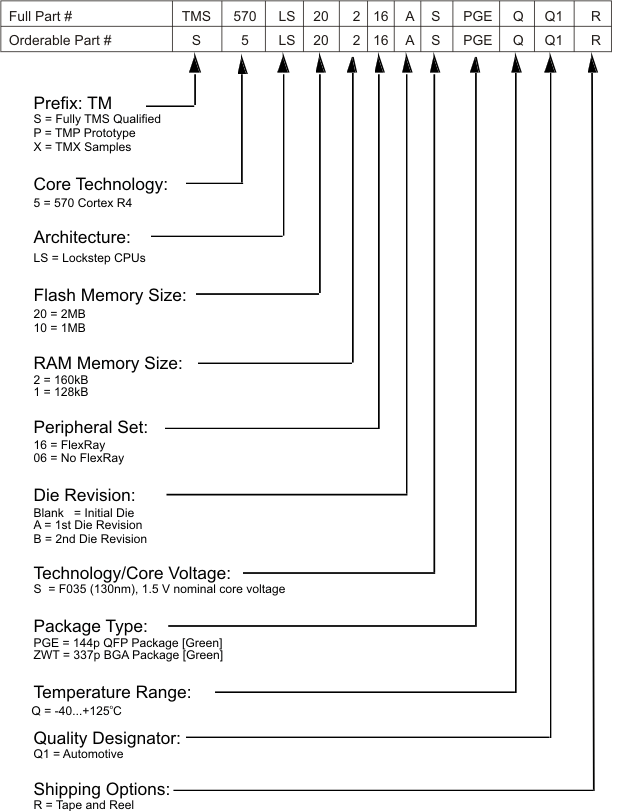SPNS141G August 2010 – October 2018 TMS570LS10106 , TMS570LS10116 , TMS570LS10206 , TMS570LS20206 , TMS570LS20216
PRODUCTION DATA.
- 1 TMS570LS Series 16/32-BIT RISC Flash Microcontroller
- 2 Device Overview
- 3 Reset / Abort Sources
-
4 Peripherals
- 4.1 Error Signaling Module (ESM)
- 4.2 Direct Memory Access (DMA)
- 4.3 High End Timer Transfer Unit (HET-TU)
- 4.4 Vectored Interrupt Manager (VIM)
- 4.5 MIBADC Event Trigger Sources
- 4.6 MIBSPI
- 4.7 ETM
- 4.8 Debug Scan Chains
- 4.9 CCM
- 4.10 LPM
- 4.11 Voltage Monitor
- 4.12 CRC
- 4.13 System Module Access
- 4.14 Debug ROM
- 4.15 CPU Self Test Controller: STC / LBIST
- 5 Device Registers
- 6 Device Electrical Specifications
-
8 Peripheral and Electrical Specifications
- 8.1 Clocks
- 8.2 ECLK Specification
- 8.3 RST And PORRST Timings
- 8.4 TEST Pin Timing
- 8.5 DAP - JTAG Scan Interface Timing
- 8.6 Output Timings
- 8.7 Input Timings
- 8.8 Flash Timings
- 8.9 SPI Master Mode Timing Parameters
- 8.10 SPI Slave Mode Timing Parameters
- 8.11 CAN Controller Mode Timings
- 8.12 SCI/LIN Mode Timings
- 8.13 FlexRay Controller Mode Timings
- 8.14 EMIF Timings
- 8.15 ETM Timings
- 8.16 RTP Timings
- 8.17 DMM Timings
- 8.18 MibADC
- 9 Revision History
- 10Mechanical Packaging and Orderable Information
Package Options
Refer to the PDF data sheet for device specific package drawings
Mechanical Data (Package|Pins)
- ZWT|337
Thermal pad, mechanical data (Package|Pins)
Orderable Information
2.6.1 Device and Development-Support Tool Nomenclature
To designate the stages in the product development cycle, TI assigns prefixes to the part numbers of all devices and support tools. Each commercial family member has one of three prefixes: TMX, TMP, or TMS (e.g.,TMS570LS20216ASPGEQQ1). Texas Instruments recommends two of three possible prefix designators for its support tools: TMDX and TMDS. These prefixes represent evolutionary stages of product development from engineering prototypes (TMX/TMDX) through fully qualified production devices/tools (TMS/TMDS).
Device development evolutionary flow:
- TMX Experimental device that is not necessarily representative of the final device's electrical specifications.
- TMP Final silicon die that conforms to the device's electrical specifications but has not completed quality and reliability verification.
- TMS Fully-qualified production device.
Support tool development evolutionary flow:
- TMDX Development-support product that has not yet completed Texas Instruments internal qualification testing.
- TMDS Fully qualified development-support product.
TMX and TMP devices and TMDX development-support tools are shipped against the following disclaimer:
"Developmental product is intended for internal evaluation purposes."
TMS devices and TMDS development-support tools have been characterized fully, and the quality and reliability of the device have been demonstrated fully. TI's standard warranty applies.
Predictions show that prototype devices (TMX or TMP) have a greater failure rate than the standard production devices. Texas Instruments recommends that these devices not be used in any production system because their expected end-use failure rate still is undefined. Only qualified production devices are to be used.
TI device nomenclature also includes a suffix with the device family name. This suffix indicates the package type (for example, PGE), the temperature range (for example, "Blank" is the commercial temperature range), and the device speed range in Mega Hertz.
